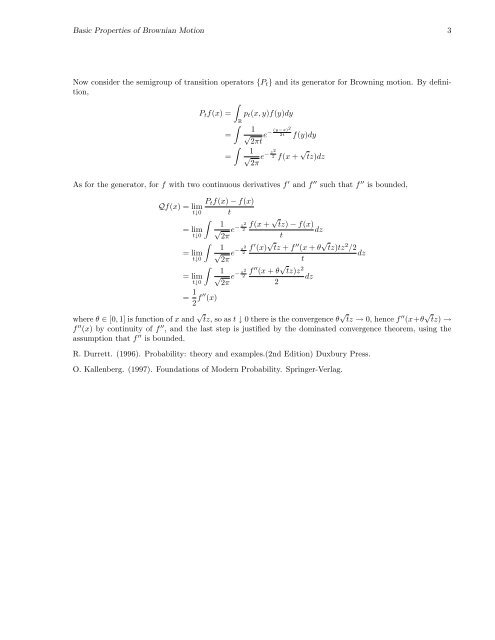Basic Properties of Brownian Motion
Basic Properties of Brownian Motion
Basic Properties of Brownian Motion
You also want an ePaper? Increase the reach of your titles
YUMPU automatically turns print PDFs into web optimized ePapers that Google loves.
<strong>Basic</strong> <strong>Properties</strong> <strong>of</strong> <strong>Brownian</strong> <strong>Motion</strong> 3<br />
Now consider the semigroup <strong>of</strong> transition operators {Pt} and its generator for Browning motion. By definition,<br />
<br />
Ptf(x) = pt(x, y)f(y)dy<br />
R <br />
1 (y−x)2<br />
−<br />
= √ e 2t f(y)dy<br />
2πt<br />
<br />
1 z2 −<br />
= √ e 2 f(x +<br />
2π √ tz)dz<br />
As for the generator, for f with two continuous derivatives f ′ and f ′′ such that f ′′ is bounded,<br />
Ptf(x) − f(x)<br />
Qf(x) = lim<br />
t↓0 t<br />
= lim<br />
t↓0<br />
= lim<br />
t↓0<br />
= lim<br />
t↓0<br />
<br />
<br />
<br />
= 1<br />
2 f ′′ (x)<br />
1 z2 − √ e 2<br />
2π<br />
1 z2 − √ e 2<br />
2π<br />
1 z2 − √ e 2<br />
2π<br />
f(x + √ tz) − f(x)<br />
dz<br />
t<br />
f ′ (x) √ tz + f ′′ (x + θ √ tz)tz2 /2<br />
dz<br />
t<br />
f ′′ (x + θ √ tz)z 2<br />
where θ ∈ [0, 1] is function <strong>of</strong> x and √ tz, so as t ↓ 0 there is the convergence θ √ tz → 0, hence f ′′ (x+θ √ tz) →<br />
f ′′ (x) by continuity <strong>of</strong> f ′′ , and the last step is justified by the dominated convergence theorem, using the<br />
assumption that f ′′ is bounded.<br />
R. Durrett. (1996). Probability: theory and examples.(2nd Edition) Duxbury Press.<br />
O. Kallenberg. (1997). Foundations <strong>of</strong> Modern Probability. Springer-Verlag.<br />
2<br />
dz



